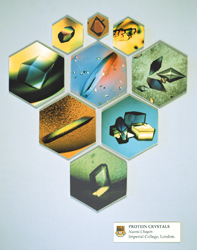Project Success Stories - Crystal gazing into protein molecular structure
Specificity on a molecular level is a prerequisite of rational design of pharmaceutical products. For the drug to tinker successfully with cellular biochemical cascades, a specific functional group must lock on to the target protein. This way, an unwanted reaction can be negated, or conversely, a desired pathway can be switched on. The best way to determine the atomic structure of many materials is to use X-ray crystallography to produce a three-dimensional picture of electrons. The stumbling block has always been how to obtain high-quality crystals, a process that starts with nucleation when stable nuclei are formed. The nuclei can then go on to grow into single diffracting crystals. As a result, the goal of many research groups was, and still is, to produce a universal nucleant. Naomi's Nucleants™ represent the most successful development yet. With the support of the project Opticryst under the EU's Sixth Framework Programme, Prof. Naomi Chayen, Biomolecular Medicine, Imperial College London and her colleagues drew and expanded on two decades of multidisciplinary research to reach a formulation that induces nucleation in many proteins that have so far presented difficulties during crystallisation. Materials previously tested on the way to this breakthrough included minerals, mica, pulverised seaweed and horse hair. Three main criteria found to stimulate nucleation are electrostatically charged surfaces, roughness and, perhaps most importantly, the presence of pores. Porous silicon proved to be a successful nucleant during trials for Prof. Chayen and her team and this encouraged them to explore further down this particular avenue. An amorphous mesosporous bioactive gel-glass, known as bio-glass, the ingredient of Naomi's Nucleants™ was used as the result of their research. In line with previous investigations, the material has a range of pore sizes, from two to ten nanometres wide, and a great variety of shapes. Pore size is crucial, being small enough to encourage the filling of the tiny hole, yet large enough to continue growth once the crystal emerges. Amongst the proteins that can be crystallised by Naomi's Nucleants™ is a modulator of heart contraction and a peptide hormone that may be a candidate for controlling appetite. For possible application in the areas of ecology and conservation, crystals of the natural algal and lobster shell pigmented proteins that promise to replace toxic or carcinogenic pigments can be produced. Naomi's Nucleants™ operate over a wide range of pH, avoid twinning whereby two separate crystals grow together on one plane, promote controlled nucleation and the resultant crystals are easy to detach. Perhaps the most important aspect is that the product represents a major move towards a universal nucleant, facilitating the crystallisation of 14 proteins, the highest number for a single nucleant yet recorded. Naomi's Nucleants™ can be purchased from Molecular Dimensions Limited at http://moleculardimensions.com/(opens in new window). The product presently occupies a slot in the front page with the title "Nucleating grains - the most effective of any tested." and is listed under new products. The role of this novel product in structural genomics and rational drug design cannot be overstated. Moreover, proteins are the cellular labourers of all life systems. As such, their molecular structure can turn the key to a whole myriad of life science applications.



